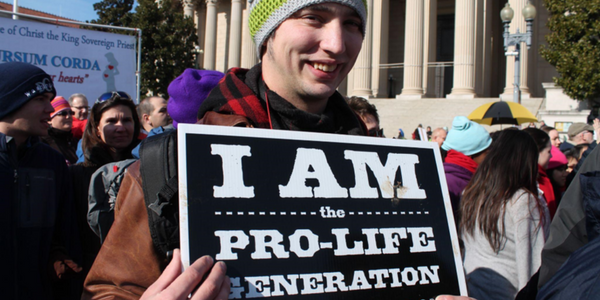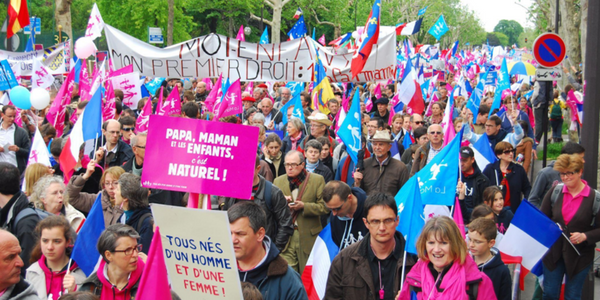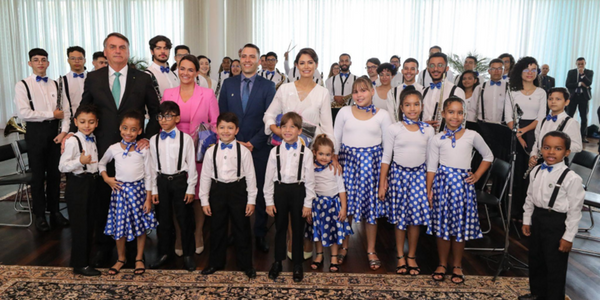By Ivan Tranfić and Timo Koch
The study of anti-gender movements highlights the discursive dimension of opposition to gender and sexual equality (GSE). The ‘gender ideology’ (GI) frame is used to denounce women’s and LGBTIQ+ equality as an attack on the essence of the sex binary and the corresponding family model centered around procreation, conservative morality, and nativism. It paints a traditionalist picture of a society that enshrines the heteronormative family model as a backbone of healthy nation-states and a bulwark against liberal moral relativism.
Talk of ‘gender ideology’ has successfully entered the mainstream in many countries and has been taken up by various liberal and conservative political groups. ‘Gender ideology’ became the all-encompassing term that clusters a wide variety of actors with different political stances and strategies into a group that appears coherent. However, the impression of a cohesive set of political actors with an agenda is not reflected in the mobilization, organizational structures, and activism of anti-gender movements and is thus misleading. Therefore, we need to go beyond discourse-focused analyses to examine how different actors participate in this increasingly connected and transnational movement in more detail. In this piece, we propose two directions for studying anti-gender movements.
Firstly, the change from the study of gender and sexual discourses to the analysis of actors and, secondly, the emphasis on religious groups and values as central forces for movement mobilization. These focal changes are also important for understanding the transnational dimension of anti-gender mobilization.
Despite the usefulness of the novel concept of anti-gender movements to grasp a new phenomenon, there is still some conceptual confusion and a lack of delimitation in the field. Going beyond the analysis of frames, research also needs to address further what kind of strategies the actors employ and which organizational resources they rely on. The proliferation of research on anti-gender mobilization creates a risky opportunity for scholars to bandwagon all actors opposing GSE as belonging to the anti-gender movement. In addition, there are actors who use the GI frame but do not consider themselves a part of the movement, as well as those belonging to the movement who don’t use the term in their claims and meaning-making.
For example, it might be evident that ‘gender critical’ feminists and far-left actors opposing ‘identity politics’ cannot be grouped with right-wing religious radicals, because they neither share a common identity or strategies, nor rely on a common set of organizational structures. However, focusing on the discursive elements of their claims points us towards recognizing commonalities among various actors rejecting some form of ‘gender ideology’ or theory. Indeed, in some outlier cases, such as the UK, discursive coalitions may be formed between far-right and left-wing or ‘radical’ feminist actors (Bassi and Lafleur, 2022). Nevertheless, we suggest that focusing on movements instead of discourses means delineating a distinct set of actors with a common, albeit somewhat loose, collective identity and ideology. In this sense, the anti-gender movement is a heterogeneous network of religious, conservative, and far-right actors opposing ‘gender ideology’ in favor of heteronormative family values.
As previously mentioned, some actors rarely use the GI frame but make up the central organizational and discursive nodes in anti-gender networks. One example is anti-abortion groups which frame their claims in terms of an affirmative celebration of life from conception against the liberal ‘culture of death’. These framing strategies have been used by Christian anti-abortion movements long before the ‘gender ideology’ frame was created (see Durham and Power, 2010; Flowers, 2019). Another example would be ‘pro-family’ actors in Orthodox contexts where the Catholic-originating GI frame did not take root, and attacks are made against LGBT or homosexual ideology instead. For instance, the Serbian movement-party Dveri, a World Congress of Families affiliate, fights the ‘totalitarian ideology of homosexualism’ (Jovanović 2018).
2015 March for Life in Washington DC (Flickr, Creative commons)
Anti-Gender Mobilization and the Transnational Christian Right
What makes these groups still recognizable as members of a broader anti-gender movement?
The term ‘anti-gender movement’ has been around since the mid-2010s (Kováts and Põim 2015), but it does not ascribe a set of features. Still, it is used to refer to actors involved in campaigns against abortion, gender equality, sex education and LGBTQ+ rights in Western Europe and Central and Eastern Europe (see Kuhar and Paternotte, 2018, but also Köttig et al. 2017). However, most studies exploring these campaigns relied on national case studies and did not reflect deeply on the transnational dimension of the movement.
Firstly, various actors have organizational links and share a unified agenda with transnational anti-gender organizations such as the World Congress of Families, the Alliance Defending Freedom (ADF) or the European Christian Political Movement (ECPM), to name a few (see Stoeckl, 2020; Dick, 2021; Datta, 2021).
Secondly, they use innovative framing of human rights, democracy, and conservative identity politics centered around parents’ and children’s rights to oppose GSE.
Thirdly, they engage in collective action by combining online and offline petitioning, roundtables and public forums, referendum campaigns, vigils, public prayer, and litigation.
Therefore, if we want to understand the phenomenon’s growing transnational relevance, we argue in favor of a social movement, actor-centered approach that can account for coalition building, cooperation, and conflict, as well as the ideological mosaic of diverging claims and identities. For these purposes, we subscribe to della Porta and Diani’s understanding of social movements as dense, informal networks of actors with a shared collective identity who engage in political and/or cultural conflicts to promote or oppose social change (della Porta and Diani, 2020).
Anti-Gender Campaigns and Religious Movements
What should we root this social movement approach in? One common feature of anti-gender mobilizations on different levels is religion. Although the current, mostly Eurocentric, approach overemphasizes outlier cases where religious groups were less active, a transnational perspective allows us to fully grasp the centrality of religion. This is particularly relevant in Latin American and African countries where Catholic and Evangelical activists are at the forefront of the movement. Even when looking at outlier cases like Hungary and France, Christian symbolism plays a vital role in identifying a threat narrative for civil society actors in the former (Geva and Santos, 2021), and Catholic intellectuals formed the core groups of the main anti-gender organizations in the latter (Raison Du Cleuziou, 2019).
Existing literature, indeed, recognizes the centrality of the Catholic church and other Christian denominations in producing and disseminating contention around gender. Authors have analyzed the Catholic roots of the GI frame, the theological and doctrinal understandings of the complementarity between women and men, as well as the socio-political relevance of Christian fundamentalism and integralism for the anti-gender movement (Bracke and Paternotte, 2016; Garbagnoli, 2016; Corrêa et al. 2020; Tranfić, 2022). Finally, some of the most fruitful early attempts to conceptualize and theorize the phenomenon came from studies of religion (Casanova, 1996; Vaggione, 2005). Most of these works focus on the religious dimension of anti-gender movements by elaborating on the importance of history, context, religious doctrine, or church-state relations. We think a fruitful expansion would bridge anti-gender studies with debates on religiously inspired collective action. Novel analytical approaches have been developed through the cross-fertilization of social movement and religious studies (for some examples, see: Burns and Kniss 2013; Hannigan 1991; Kirmani 2008).
The Manif pour Tous Protest in Paris, France, 2013 (Flickr, Creative commons)
Following this strand of scholarship can help us to understand how religions provide movements with resources, beliefs, and identities and to grasp the specificity of religious movements. If we look at resource mobilization, organizational networks, identity-building, and cultural production of the movement, the core of the transnational anti-gender efforts is clearly formed by networks of Christian right actors. The Christian right can be defined as a broad range of (trans)national organizations, coalitions, and networks promoting an “orthodox Christian vision and a defense of the traditional nuclear family” (Buss and Herman, 2003). Broadly speaking, this includes churches and clergymen, lay communities of activists, as well as transnational faith-based think tanks, universities, and NGOs. In this sense, we suggest treating religious groups that engage in power relations as other political organizations, i.e., as having internally defined goals, interests, and strategies they adopt in pursuing them (Potz, 2020).
As a religiously inspired social movement, the anti-gender movement relies on religion-specific resources like transcendental motivation, shared transnational identification with Christianity, and a rich, decentralized network of supporting organizations, networks, and resources (Smith 1996). In addition, religion-specific strategies and repertoires are ready-made and accessible to anti-gender actors. Osa’s work (1997) on the communist-era Catholic strategy of indirect confrontation with the state illustrates how rituals and events are politicized within the Catholic associational sphere. Similarly, Davis and Robinson (2012) identify a state-bypassing strategy used by various denominations in constructing parallel conservative civil societies.
Religious Agency and Transnational Mobilization
The change of focus away from discourses and ‘secular’ actors also has a set of methodological implications. Emphasizing religious groups as crucial, the analytical focus shifts towards studying religious agency facilitated both from the transnational level to the local and vice versa. While not all groups mobilizing against ‘gender ideology’ are religious, a transnational movement approach would also benefit from cross-fertilization with the scholarship on religion and social movements. The usual puzzle of far-right studies emphasizing the paradox of transnational cooperation of nationalists gives way to a more complex picture. With universal Christian collective identification as a useful resource for transnationalization, far-right actors can move beyond nationalist ideology by collaborating on a common illiberal, heteronormative agenda.
In addition to religion, transnational anti-gender movements frequently cooperate with illiberal lawyer associations (Mancini and Palazzo, 2021) and draw on the knowledge that international think tanks produce (Jezierska et al., 2021). Shifting the focus from anti-gender discourses towards the agency of actors presents new opportunities in researching the role of organizations such as think tanks, foundations, and lawyer associations. Moreover, it paves the way for a more systematic analysis of Christian right movements that include both conservative and far-right actors.
Jair Bolsonaro and Katalin Novák, presidents of Brazil and Hungary, both important actors in the transnational anti-gender networks (Flickr, Creative commons)
In conclusion, the study of Christian right and far-right movements should take the religious dimension of mobilization seriously. Existing far-right scholarship observes activists as outsiders rather than from within their field of inquiry (Castelli Gattinara, 2020). This leads to the exclusion of theological narratives, faith-based motivation, and affective investment relevant to understand the phenomenon. A reconceptualization of the relationship of cross-movement coalitions implies accounting for the interaction among parties, social movements, and religious groups. This observation gains more relevance in light of the increasing interlinks among organizations and the mainstreaming of the far right (Pirro, 2022),
Previous research rightly indicated the relevance of religious influences, highlighting the interaction between the French Manif pour Tous and Catholicism in France (Paternotte et al. 2016) or the Vatican’s intervention in reproductive rights in Latin America (Vaggione, 2020). These important examples focusing on institutional actors and churches are, however, often limited to country cases and do not reflect on the role of international Christian NGOs. Just as gender is still a neglected topic in the study of the radical right (Mancini and Palazzo, 2021), it is past time to deepen our understanding of the religious elements of anti-gender mobilization and to highlight the Christian right as an important illiberal actor on the global stage.
Ivan Tranfi is a PhD candidate in Political Science and Sociology at the Scuola Normale Superiore and a member of the Center of Social Movement Studies (COSMOS) in Florence, Italy. He holds a BA and an MA degree in Political Science from the University of Zagreb, and an MA in Nationalism Studies from Central European University, Budapest. His research explores the role of lay activists, churches and parental associations mobilizing for traditional family values. Specifically, his PhD project examines radical-right opposition to ‘gender ideology’ and abortion in the Balkans.
Timo Koch is a PhD student in International Politics at City, University of London. He holds an MA in Gender Studies from Utrecht University. His research explores the transnationalization of far-right family politics through international conferences and he is currently working on a project that investigates the relationship of the radical right and structural religious and ethnic inequalities in Europe.




